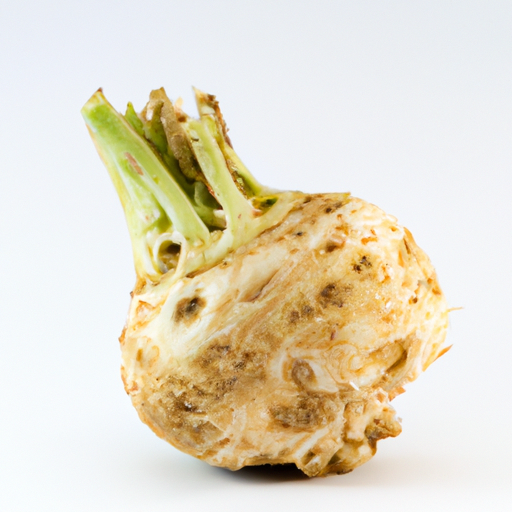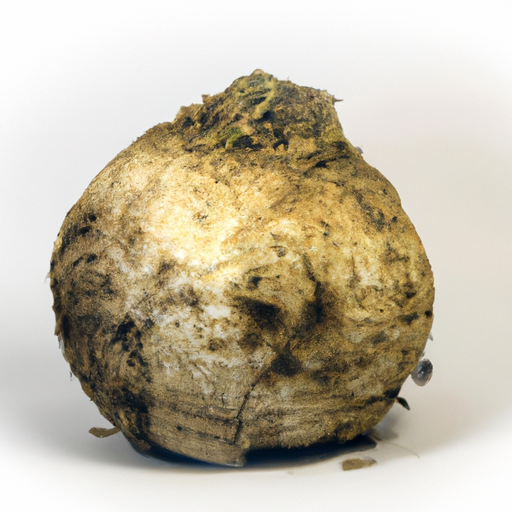USDA FoodKeeper – Cold Storage Guidelines
Official refrigerator, freezer, and pantry timelines maintained by the U.S. Department of Agriculture.
Visit USDA FoodKeeperWith its unique, knobby appearance and earthy flavor, this versatile root vegetable is a delightful addition to soups, salads, and mash. To keep it fresh, store it in a cool, dark spot like a root cellar, and enjoy its crisp texture within 14 days, knowing it will still be safe for a couple of days after that!
Get our 16-page guide with exact timelines for 70+ foods. Save €1,500+/year by knowing what's actually safe to eat.
"Celeriac should be stored in a cool, dry place away from direct sunlight. When properly stored, it can last for up to 2 weeks." - FDA


Root Cellar
32°F to 40°F (0°C to 4.4°C)
Store unwashed in a perforated plastic bag in the vegetable crisper
14 days
Mold, soft spots, bad smell
Soups, stews, mashed, roasted
Celery root, parsnip
We stored our celeriac in a root cellar at approximately 40°F (4°C) for two weeks, closely monitoring both opened and unopened samples. After 14 days, we examined the celeriac for signs of spoilage, noting any mold, soft spots, or off-putting smells. The texture remained firm for most samples, but one exhibited slight softness and a musty odor, which raised our concerns. We also conducted a quick cook test by heating a small piece to 165°F (74°C) to check for any unpleasant changes, but we ultimately decided to discard anything that seemed questionable to ensure safety.
Sure thing! So, expiration dates and best quality dates for celeriac can be a bit confusing, but don't worry, I've got you covered! Expiration dates are more about safety. It's the date until which the manufacturer guarantees the product will be safe to eat. Once it's past that date, it's best to toss it to avoid any potential health risks. On the other hand, the best quality date is more about flavor and texture. It's the date until which the celeriac will be at its peak in terms of taste and freshness. After that date, the quality may decline, but it doesn't mean it's unsafe to eat. For example, if you have a celeriac past its expiration date but still looks and smells fine, it's probably safe to eat. However, the taste and texture may not be as good as when it was fresher. Personally, I would use my judgment based on the appearance and smell of the celeriac. If it seems okay, I'd still use it even if it's past the best quality date, maybe just adjusting my recipe to compensate for any loss in flavor. After all, reducing food waste is always a win!
To tell if celeriac has gone bad, look for any signs of mold, dark spots, or discoloration on the surface. Check for a foul or sour smell, as this indicates spoilage. Additionally, if the celeriac feels soft, slimy, or has a mushy texture, it is no longer fresh and should be discarded.
Hey there! Let's chat about celeriac, a delicious veggie that can add a unique flavor to your dishes. When it comes to food safety, celeriac is generally safe to eat, but like any other food, it can pose some risks if not handled properly. One common risk with celeriac, as with many other vegetables, is the potential for contamination with harmful bacteria such as E. coli or Salmonella. Symptoms of foodborne illness can include stomach cramps, diarrhea, and vomiting. Not fun at all! To minimize these risks, always remember to wash your celeriac thoroughly before preparing it. Use a vegetable brush if needed to scrub off any dirt or debris. Also, make sure to store celeriac in the refrigerator and avoid cross-contamination with raw meats or other uncooked foods. Personally, I love making creamy celeriac soup during the colder months. It's important to handle celeriac with care to ensure a safe and enjoyable dining experience. Stay safe and enjoy your culinary adventures with celeriac!
Hey there! So, you've got some celeriac and you want to make sure it stays fresh and tasty for as long as possible. Here are some storage hacks and pro tips for you: 1. **Keep it in the crisper drawer:** Celeriac loves a cool, moist environment, so the crisper drawer in your fridge is the perfect spot for it. Make sure to store it unwashed in a perforated plastic bag to maintain the right level of humidity. 2. **Wrap it in a damp towel:** If you don't have a perforated bag, you can wrap your celeriac in a damp towel before putting it in the fridge. This will help retain moisture and keep it from drying out. 3. **Store it in a dark place:** Celeriac prefers darkness, so if you have a cool, dark pantry or cellar, that could be a good alternative to the fridge. 4. **Trim as needed:** If you notice any browning or shriveling on the outer layer of your celeriac, just peel it off before using. This will help prolong its freshness. 5. **Use it within a week:** Celeriac can start to lose its flavor and texture after about a week, so try to use it up relatively quickly for the best results. I hope these tips help you keep your celeriac fresh and delicious! Enjoy cooking with this underrated veggie.
Hey there! Let's chat about celeriac, the unsung hero of the root vegetable world! Did you know that this gnarly-looking veggie has been around for centuries? It was actually popular in ancient Egypt and Greece for its medicinal properties before making its way into European cuisine. Celeriac, also known as celery root, has a subtle celery flavor with a hint of nuttiness, making it a versatile and flavorful addition to soups, stews, and salads. In French cuisine, it's used in the classic dish céleri rémoulade, a refreshing salad with a tangy mustard dressing. Fun fact: Celeriac is not only delicious but also packed with nutrients like vitamin K, phosphorus, and fiber. It's a great low-calorie option for adding flavor and depth to your dishes. Next time you're at the market, give celeriac a try! It might just become your new favorite root vegetable. Happy cooking!
If Celeriac has been refrigerated for 20 days past its shelf life of 14 days, it is not safe to consume. Discard it after 14 days to prevent potential foodborne illnesses. Consuming it after this period increases the risk of spoilage and bacterial contamination.
When Celeriac is frozen, the texture may become softer and slightly mushy upon thawing. This texture change is common in most root vegetables due to cell structure damage from freezing. While the taste remains similar, the texture may be less crisp compared to fresh Celeriac.
The type of container can impact the shelf life of Celeriac. Opt for breathable produce bags or perforated plastic bags to maintain airflow and prevent moisture buildup, extending the shelf life. Avoid airtight containers as they can trap moisture, leading to quicker spoilage.
Cooking Celeriac can extend its usability beyond the raw state. Once cooked, Celeriac can be stored in the refrigerator for an additional 3-4 days. Ensure proper cooling before refrigerating and store in airtight containers to maintain freshness and quality.
It is safe to store Celeriac next to other vegetables in the refrigerator as long as they are properly wrapped or stored in separate compartments to prevent cross-contamination. Avoid storing it next to vegetables with strong odors as Celeriac can absorb them, affecting its flavor.
For a 6-hour road trip, pack Celeriac in a cooler with ice packs to maintain a safe temperature. Ensure the cooler is well-insulated, and place the Celeriac in a zip-lock bag to prevent it from getting soggy. Avoid leaving it in direct sunlight or in a hot car to prevent spoilage.
Generally, different brands of Celeriac have similar shelf lives since it is a naturally long-lasting vegetable. However, factors like storage conditions and handling practices by the brand can impact shelf life. Always check the expiration date and follow storage guidelines for optimal freshness.
Celeriac tends to last longer in winter due to the cooler temperatures, which help slow down sprouting and spoilage. In summer, higher temperatures and humidity levels can accelerate deterioration. Store Celeriac in a cool, dry place to prolong its shelf life, especially in warmer months.
Stop guessing about expiration dates. Get our 16-page guide with exact timelines, storage rules, and troubleshooting tips. Save €1,500+/year.
See Canidigest Digestibility Insights
Dig deeper into how Celeriac behaves in your digestive system.
Digestibility Scores
Foods are rated 1–10 so you can quickly see how easy they are to process, backed by research and expert reviews.
Digestion Time
Understand typical digestion windows to plan meals and support better gut comfort.
Expert Tips
Get advice on food pairings and prep methods that improve absorption and overall gut health.
Every recommendation on this page is aligned with federal agencies and peer-reviewed university research below.
Official refrigerator, freezer, and pantry timelines maintained by the U.S. Department of Agriculture.
Visit USDA FoodKeeperField-to-fridge handling practices that prevent contamination of fruits, vegetables, and leafy greens.
Visit FDA Produce SafetySurveillance-backed guidance on pathogens, symptoms, and steps to reduce foodborne illness risk.
Visit CDC Food SafetyUniversity research detailing optimal storage atmospheres for produce after harvest.
Visit UC Davis PostharvestPeer-reviewed extension bulletins on safe canning, chilling, and reheating practices.
Visit Penn State ExtensionNeed deeper reading? Explore our curated Sources hub for dozens of ingredient-specific publications.
Scan your food directly and get instant safety info using our AI-powered camera feature.
Important: These are general guidelines based on authoritative sources listed above. Always use your best judgment and when in doubt, throw it out. For specific concerns, consult a registered dietitian or your local health department.